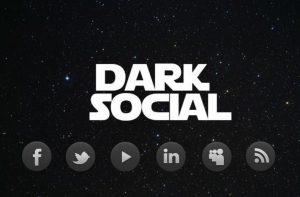07 Mar What is Dark Social Sharing
 What is dark social sharing you may well ask because not a lot of people know.
What is dark social sharing you may well ask because not a lot of people know.
As always we’re here to share our digital knowledge with you and especially if it helps you boost any aspect of your business.
So here goes…
You know when you read a really great article online and you want to share it with someone else you know, you either click Share or copy the link straight into an email, onto a Whatsapp message or via a private Facebook message.
All of these ways of sending a web link are being sent via dark social sharing.
You can see how easy it is to probably not have paid any attention to this in the past because who the heck considered it, but in terms of your business and online marketing it is actually a big deal and one you would be wise to pay attention to.
The reason it was termed Dark Social (over 6 years ago now) is because this type of sharing is literally in the dark, no one can see this sharing of digital information except the recipient and the sender which also includes analytics, meaning you don’t have a true indication of the impact your content is having across the web.
Knowing that Dark Social exists is the first step in being able to monitor it.
Your analytics just think it’s direct traffic which is effectively giving you a false reading. Dark social is actually a huge portion of your online traffic so you don’t want to ignore this! Over 80% of all shares across the web are untracked which is why it is so important.
Sadly at this moment in time you can’t track 100% of dark social sharing but you can do a couple of things to increase your insight into some of that data which you don’t currently have.
There’s a few ways to monitor your dark traffic analytics and here’s how.
Shorten Your URLs:
Bitly has a free version which works great for SME’s but if you do a lot of online marketing you may want to choose the Enterprise option for the additional features and greater control on your reporting.
Using a URL shortener won’t give you total insight into sharing but it will give you a deeper understanding of the clicks, shares, countries and demographics your content reaches. It’s a handy tool to use alongside your Google analytics to track your data journey. You may have seen people with website links in their Instagram accounts as a Bitly link, this is so they can track those clicks.
Use Platform Analytics:
Each of the social media platforms have their own inbuilt analytics which are really handy to also keep any eye on what’s going on with each post and link. Monitoring all of these areas will give you a deeper insight into how all your social data is being shared. Although this won’t help specifically with dark social sharing, when you use all of these tools together, you get a greater insight into the dark world because it brings it a little more into the light.
Use Sharing Widgets:
Widgets that you install to aid the sharing of data and articles can then be monitored and help you target specific information to the relevant channels. Making social sharing easier for your audience and then monitoring the journey of that data will give you a greater understanding of the impact your content is having online, meaning you can then target your content.
Make sure your ‘share’ buttons are easy to access on your website and also clear that they are ‘share’ and not ‘follow’ buttons.
Use Google Analytics:
Go to the Audience tab on your Google Analytics dashboard, click Overview, click Add Segment, Choose ‘Direct Traffic’, un tick any other boxes and click Apply at the bottom left.
This will help you see all the metrics that you have applied to the Direct Traffic segment which means you will be able to monitor spikes in content sharing via the dark social.
To funnel that information down further you can delve a little deeper by clicking Behaviour, Site Content and All Pages.
Now, the trick is to see if you can filter it down into discovering what dark traffic lurks beneath!
To do this you need to now click Advanced, change the selection from Include to Exclude, ensure Page is selected and in the fields next to each one type in all of your website slugs (URL page/blog Name) that are easy to remember and then click Apply.
In this segment you will now see most of the traffic that is likely to be dark traffic.
If Google tracks these URLs it’s more likely that they were copied and pasted into a message and clicked from inside a private environment such as email or Facebook Messenger.
It’s not perfect but it is a way of gaining an understanding of what percentage of your content is shared using dark social. If it’s a small percentage then it’s time to ensure your online content is impactful, informative and easy to share.
We hope this gives you an understanding of what Dark Social is and helps you bring yours a little into the light so you’re able to see it a bit more clearly and get a better ROI because of it, after all, knowledge is power!

